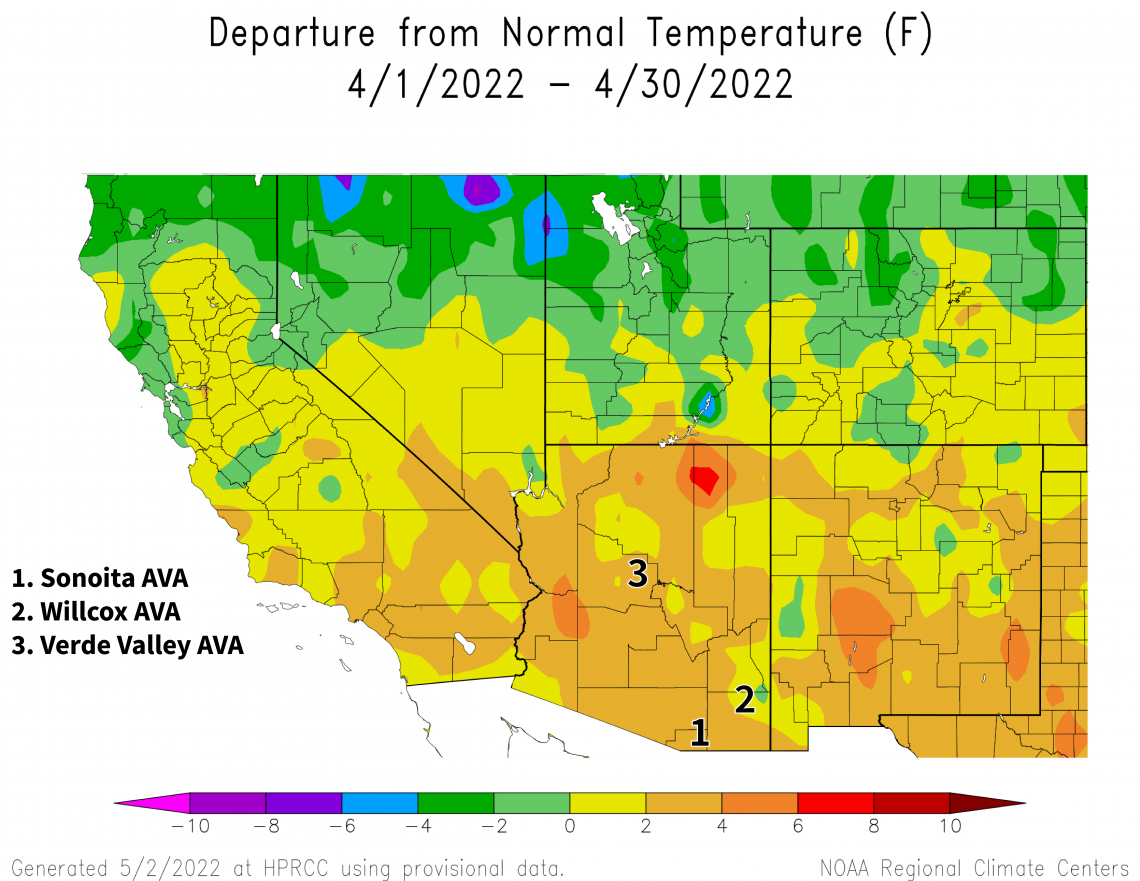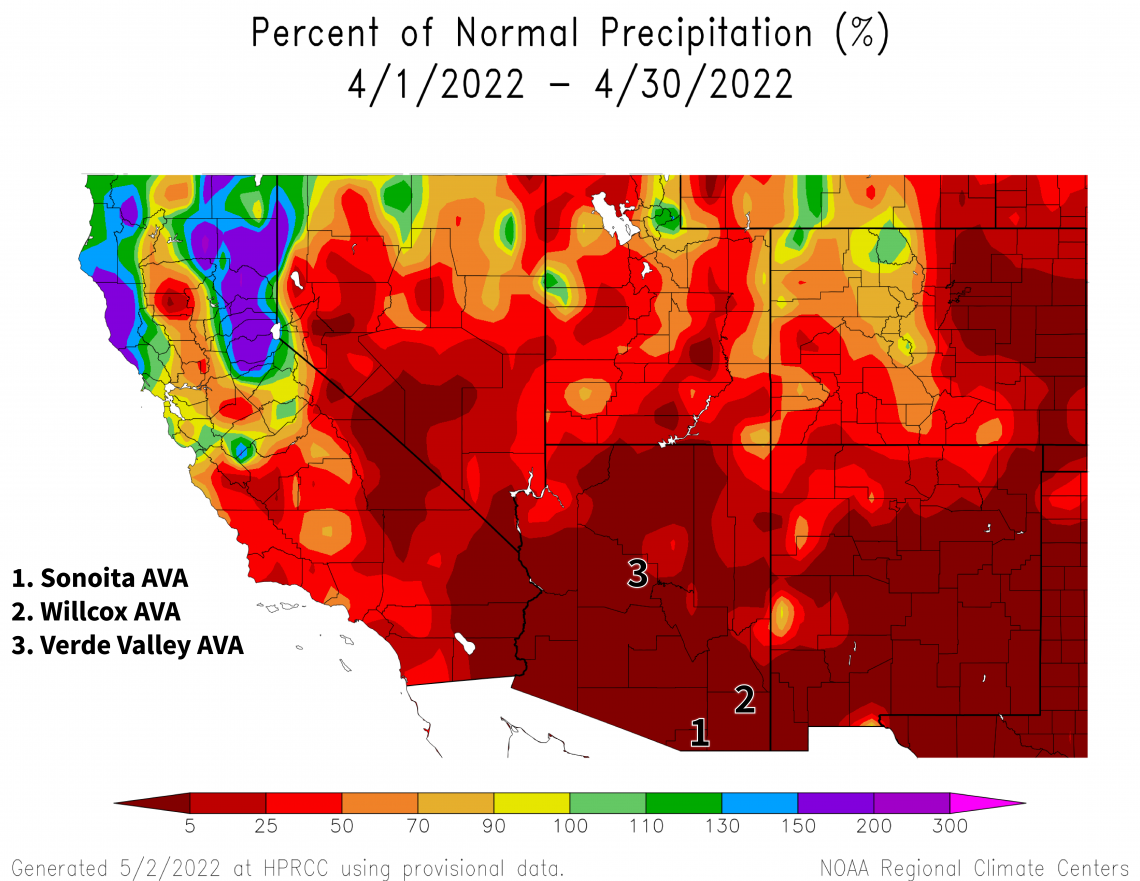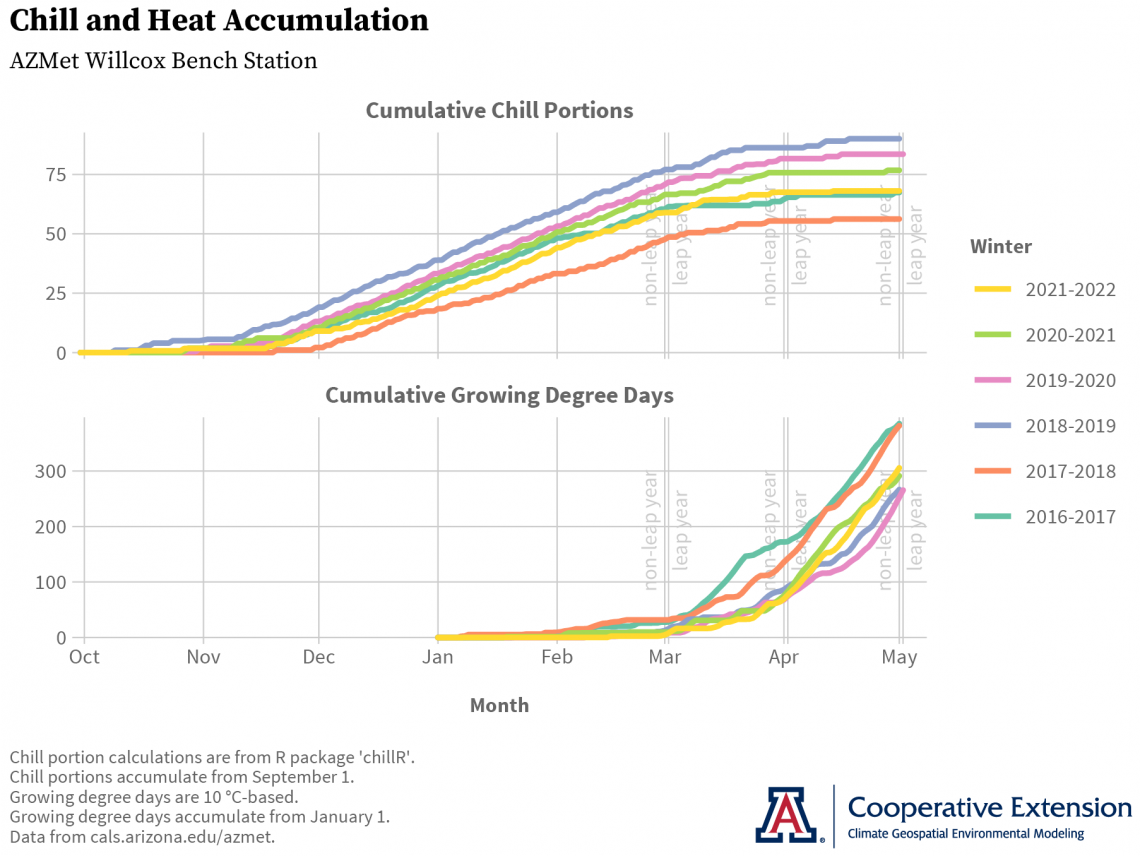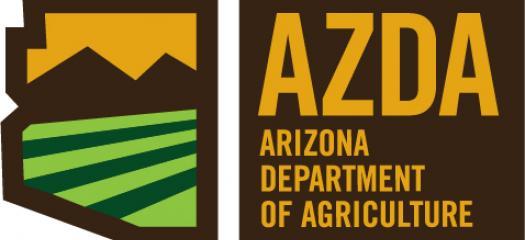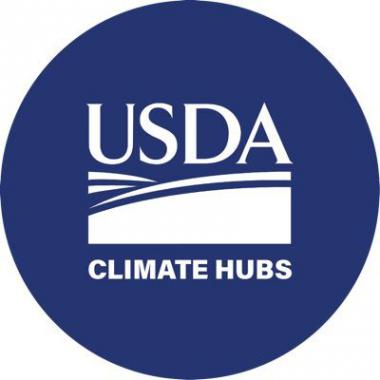Climate Viticulture Newsletter - 2022 May
< Back to Climate Viticulture Newsletter
Hello, everyone!
This is the May 2022 issue of the Climate Viticulture Newsletter – a quick look at some timely climate topics relevant to wine grape growing in Arizona.
April Recap | May Outlook | AVA Seasonal Analogs | Start of the Growing Season | Extra Notes
A Recap of April Temperature and Precipitation
Monthly average temperatures were 2 to 4 °F above the 1991-2020 normal for much of the state (light orange area on map). Some locations in north-central Arizona and along the eastern state border, like the Willcox AVA, were within 2 °F of normal (light green and yellow areas on map). This is similar to April last year, when monthly temperatures were 2 to 4 °F above the 1981-2010 normal for almost all of the state.
Below-freezing minimum temperatures mixed themselves into the middle of the month, not just in Arizona but also across the west-coast states. The event looks to have inspired an Oregon State University write up, for example, with discussion on topics like critical temperatures for buds and young shoots, vineyard floor management for damage control, and – our favorite – a figure relating temperature to topography. Yes, so-called ‘banana belts’ do exist. Perhaps interestingly, the mid-April freeze event is close to the climatological date for the last spring freeze in the Sonoita and Willcox AVAs, as well as the southeastern part of the Verde Valley AVA. For the rest of the latter, it was later than normal. Unfortunately, ‘banana belts’ aren’t unbeatable.
Monthly precipitation totals were less than 25 % of the 1991-2020 normal for much of the state (red and dark red areas on map). For many growing locations in these areas, this converts to less than 0.1 inches measured. April normally is, after all, a relatively dry month. Amounts this year are similar to or perhaps drier than April 2021, when precipitation was less than 50 % of the 1981-2010 normal for most of Arizona.
Although it’s difficult to get any drier, monthly average temperatures in April have been warmer prior to the past two years, happening in 2018, 2002, and 1989. We’ll get more into the details of this below, as we start to look at Arizona AVA analogs for the April-through-June pre-veraison part of the growing season.
View more NOAA ACIS climate maps
The Outlook for May Temperature and Precipitation
Temperatures over the course of this month have a slight increase in chances for being above the 1991-2020 normal across almost all of Arizona (orange area on map). A moderate increase in chances for above-normal temperatures exists along the east-central and southeastern state border (dark orange area on map). As a comparison, monthly temperatures in May last year were within 2 °F of normal for much of the state.
2022-may-temp-outlook-noaa-cpc.png

There are equal chances for precipitation totals this month to be below, near, or above the 1991-2020 normal for the southern two-thirds of Arizona (white area on map). A slight increase in chances for below-normal precipitation exists across the northern tier of the state (light tan area on map). Precipitation totals for May 2021 were less than 25 % of normal for almost all of Arizona.
After a relatively dry dormant season, equal chances for below-, near-, or above-normal precipitation amounts might sound good. But, much like April, May is a relatively dry month with normal amounts being no more than 0.5 inches for almost all of the state. Extra consideration of irrigation may be needed, particularly if warmer-than-normal temperatures come to pass.
Read more about the May 2022 temperature and precipitation outlook
To stay informed of long-range temperature and precipitation possibilities beyond the coverage of a standard weather forecast, check in, too, with the six-to-ten-day outlook and eight-to-fourteen-day outlook issued daily by NOAA’s Climate Prediction Center.
2022-may-prcp-outlook-noaa-cpc.png
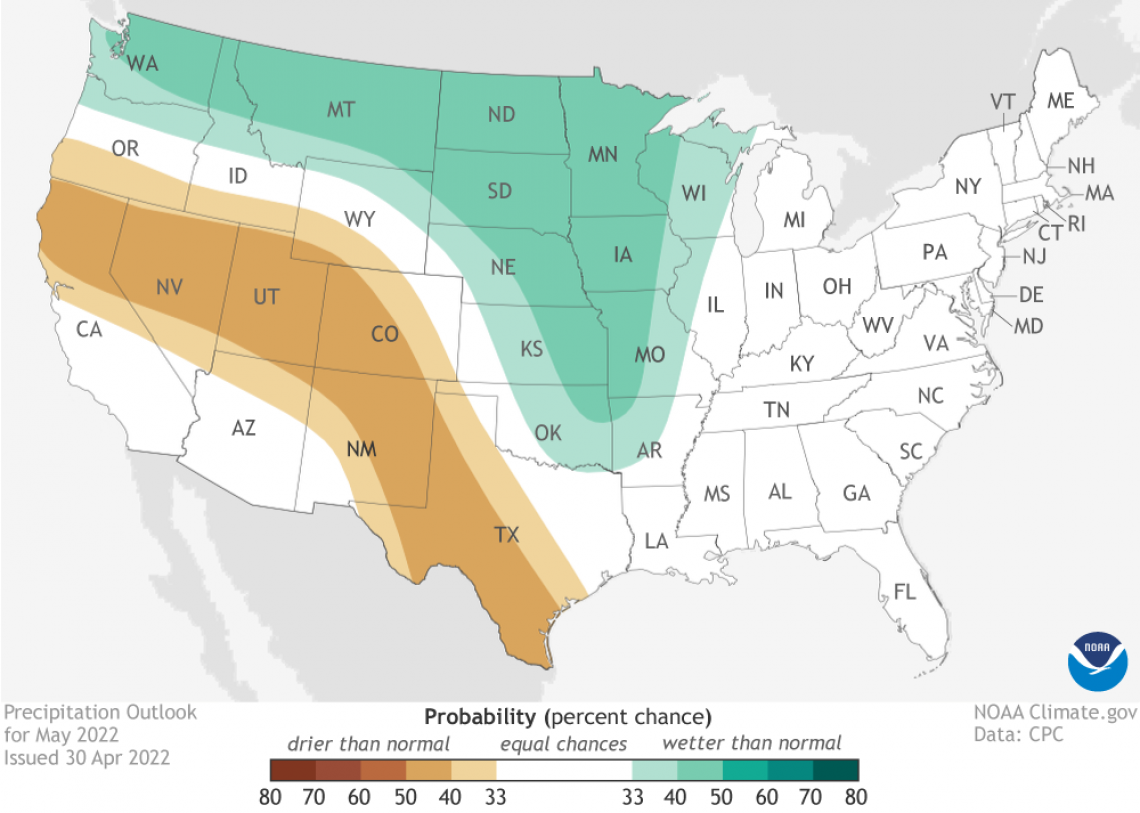
Seasonal Analogs for Arizona AVAs
From the recap above, it’s no surprise that we are starting the growing season on the warm and dry sides of the 1991-2020 normals (thick gray vertical and horizontal lines on graphs, respectively). It’s also likely not surprising that some of the most similar past conditions of temperature and precipitation are from recent years. At this early point in the 2022 growing season (dark red dots on graphs), similar past years (light red dots on graphs) are 2021, 2011, 2012, 2017, and 2002 for the Sonoita AVA, 2000, 2021, 2012, 1992, and 1987 for the Verde Valley AVA, and 2006, 2011, 1981, 1986, and 2017 for the Willcox AVA.
With this take on the analog approach from weather forecasting, we are comparing temperature and precipitation conditions in the three Arizona AVAs from this year with such conditions from past ones. Based on the past years that are most similar, coupled with other information like that from the outlook above, one can better anticipate things like growth stage timing and irrigation demand in the coming weeks. One also can more quickly select the annual vineyard notes from previous years that might be more helpful in recalling what went well and what didn’t go so well.
As there are many new wine grape growers in the state, information from these graphs also can help point out what may not be known from experience in terms of how different temperature and precipitation can be at the same point in different growing seasons. Granted, conditions in April have been warmer and drier than normal in many recent years. But, relatively cool and wet starts to the growing season have occurred, so don’t dismiss those anecdotes about 1999 just yet!
Whether a new grower or not, what we see here and in the recap and outlook above suggests that the 2022 growing season is starting off like the one in 2021, a time more likely in everyone’s experience. Possible exceptions to this similarity might be the mid-April freeze and a slightly later bud break, the latter of which we look at next.
cvn-202205-ava-analogs-2022-05-02.png

Vine Dormancy and the Start of the Growing Season
With bud break likely done in perhaps all but the latest varieties and coolest growing areas in the state, we’ll take one last look at chill and heat accumulations influencing the start of the growing season this year. Temperatures in April maintained what we observed and anticipated in the past two newsletter issues. Cumulative chill portion values in 2021-2022 are most similar to those in 2016-2017 (yellow and aqua lines, respectively, on top graph). Cumulative growing degree day values are most similar those in 2020-2021 (yellow and green lines, respectively, on bottom graph).
Due to deacclimation kinetics, less chill can translate to a slightly lower rate at which dormant buds deacclimate and a slightly longer time over which they lose cold hardiness. Or, in other words, relatively higher (lower) heat accumulation is needed for vines to start the growing season after winters with relatively lower (higher) chill accumulation.
Based on this, and with less chill accumulation this past dormant season than in the previous one (yellow and green lines, respectively, on top graph), more heat accumulation than in 2020-2021 should have been needed for bud break this year. Since cumulative growing degree days in 2021-2022 pretty much follow that from 2020-2021, reaching more means accumulating over a longer period of time and a relatively later bud break this year than last.
As we only use temperature data here from the AZMet Willcox Bench station, the above assessment of the start of the growing season is most applicable to the south-central part of the Willcox AVA. From what we’ve heard from there, bud break observations are consistent with what we’ve been anticipating. Farther away, like in the Sonoita and Verde Valley AVAs, chill and heat might have accumulated differently and their assessment through a deacclimation kinetics lens may have led to different expectations. We hope to expand bud break modeling to these areas in the future.
Drought conditions continue to influence the wildland fire season in the state. There is an above-normal potential this month for significant wildland fires in southeastern and central Arizona. Elsewhere across the state, the potential is normal.
Although weak, the ‘double-dip’ La Niña event of 2021-2022 still continues. There now is a 59 % chance that it will persist through the June-through-August period, and a 50-55 % chance it makes it into the fall. Before any thoughts of a La Niña hat trick, however, keep in mind that the current ENSO forecast for late summer and early fall is highly uncertain. After all, the latter probability above also means that there is a combined 45-50 % chance for either ENSO-neutral or El Niño conditions to instead take place. This is the most recent official forecast for ENSO, or El Niño Southern Oscillation, parts of the atmosphere and ocean across the tropical Pacific Ocean that cause El Niño and La Niña events.
For those of you in southeastern Arizona, Cooperative Extension manages an email listserv in coordination with the Tucson forecast office of the National Weather Service to provide information in the days leading up to agriculturally important events, like spring freezes and high winds. Please contact us if you'd like to sign up.
And for those of you in north-central and northeastern Arizona, Cooperative Extension is starting to coordinate with the Flagstaff forecast office of the National Weather Service to soon provide a similar email listserv for those in agriculture in this part of the state. Please contact us if you'd like to sign up.
Undergraduate students in the College of Agriculture and Life Sciences at the University of Arizona are looking for internships with businesses and companies in the viticulture and winery industries during 2022. Please contact Danielle Buhrow, Senior Academic Advisor and Graduate Program Coordinator in the Department of Agricultural and Resource Economics, for more information.
Please feel free to give us feedback on this issue of the Climate Viticulture Newsletter, suggestions on what to include more or less often, and ideas for new topics.
Did someone forward you this newsletter? Please contact us to subscribe.
Have a wonderful May!
With current and past support from:


